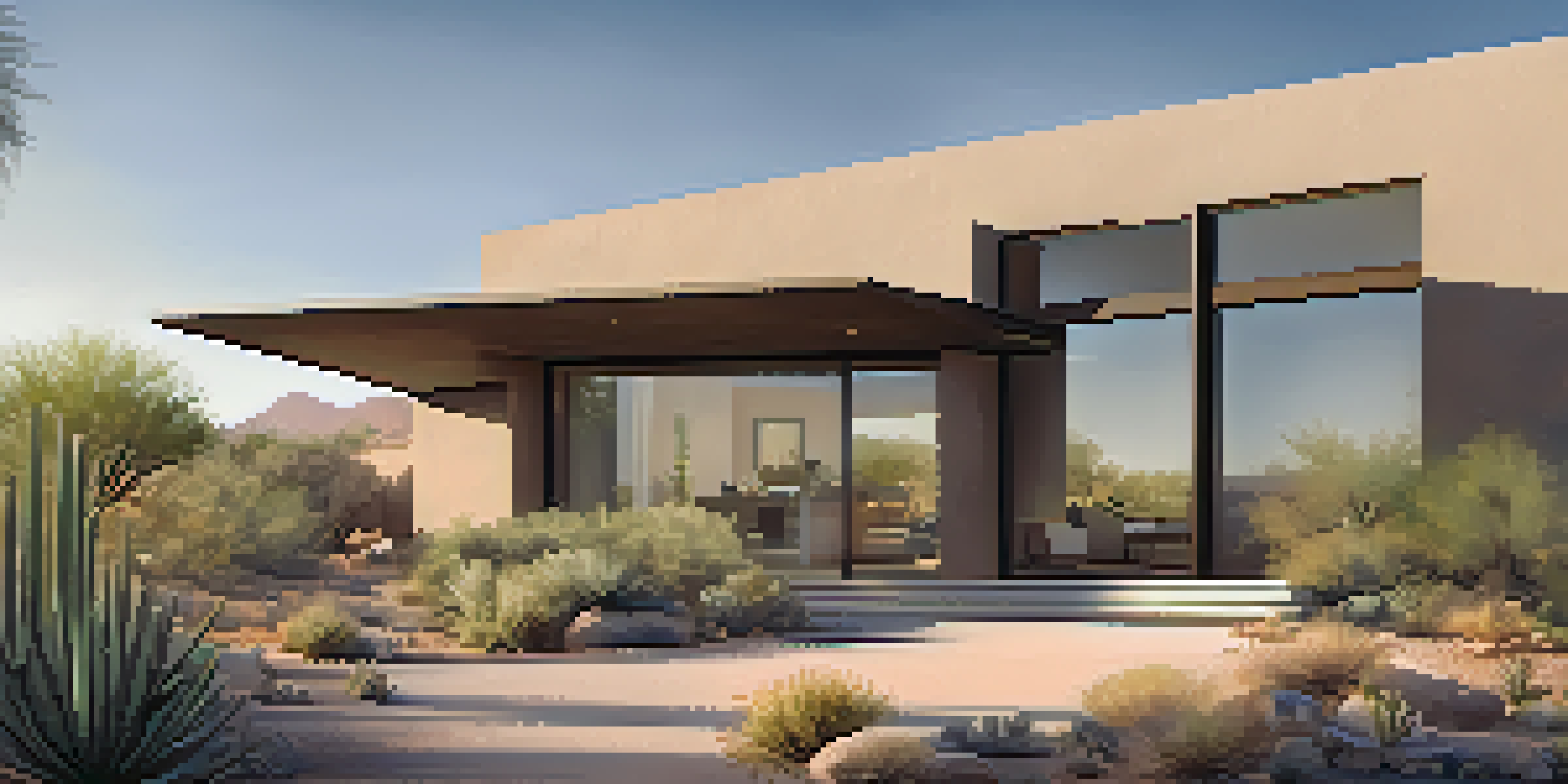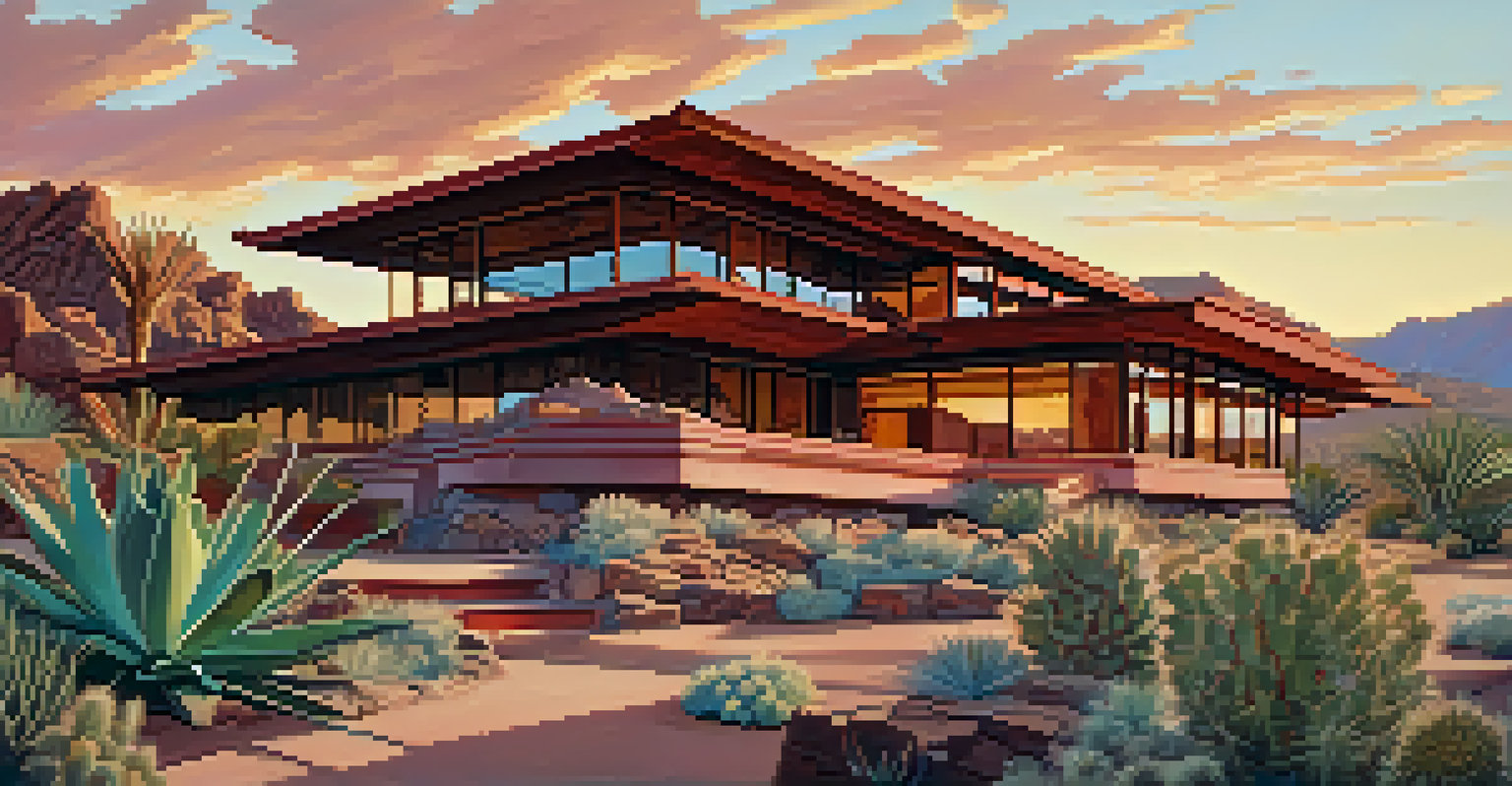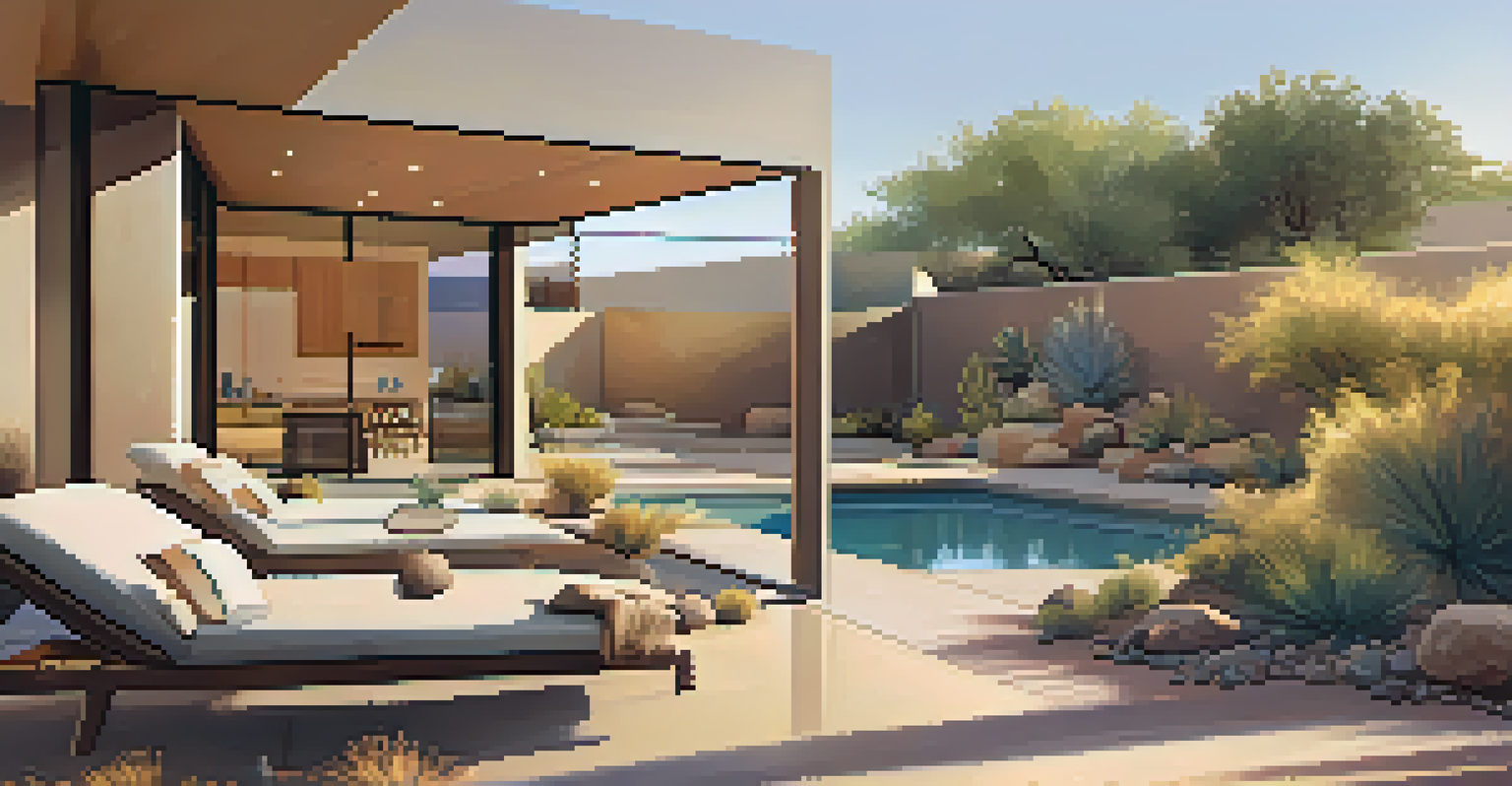Exploring Scottsdale's Iconic Desert Modern Architecture Styles

Understanding Desert Modern Architecture
Desert Modern architecture is a unique blend of functionality and aesthetics, perfectly suited for the arid landscape of Scottsdale. This style emerged in the mid-20th century and is characterized by clean lines, open spaces, and the use of natural materials. The goal is to create homes that not only stand out but also harmonize with their desert surroundings.
The mother art is architecture. Without an architecture of our own, we have no soul of our own civilization.
One key aspect of Desert Modern architecture is the seamless indoor-outdoor living experience it offers. Large windows and sliding doors invite natural light and breathtaking views inside, making the desert feel like part of the interior. This connection to nature enhances the overall living experience, allowing residents to enjoy the stunning surroundings.
Moreover, sustainability plays a significant role in these designs. Many structures incorporate energy-efficient features and sustainable materials, reflecting a growing awareness of environmental concerns. By embracing these principles, Desert Modern architecture not only showcases beauty but also promotes a responsible way of living in harmony with nature.
The Influence of Frank Lloyd Wright
Frank Lloyd Wright's impact on Scottsdale's architectural scene cannot be overstated. His philosophy of organic architecture, which emphasizes harmony between human habitation and the natural world, greatly influenced local builders and designers. Wright's designs often feature horizontal lines and natural materials, echoing the desert landscape.

One of the most notable examples of his influence is Taliesin West, Wright's winter home and architectural school. This iconic structure embodies the principles of Desert Modern architecture, blending seamlessly with the surrounding landscape. Visitors often marvel at how the building appears to grow out of the desert floor, showcasing Wright's commitment to integrating architecture with nature.
Desert Modern Architecture Defined
Desert Modern architecture blends functionality and aesthetics, using clean lines and natural materials to harmonize with the Scottsdale landscape.
Wright's legacy continues to inspire modern architects in Scottsdale. Many contemporary homes incorporate similar principles, ensuring that his vision of a harmonious relationship between nature and architecture lives on. This connection not only honors his work but also enriches the community's architectural identity.
Key Features of Desert Modern Homes
Desert Modern homes are known for their distinctive features that set them apart from other architectural styles. One of the most prominent characteristics is the use of flat or low-pitched roofs, which helps to minimize heat absorption and blend with the horizon. This design choice not only enhances aesthetics but also promotes energy efficiency.
Architecture should be rooted in the past, and yet be a part of our own time and place.
Another defining feature is the incorporation of large glass windows that frame breathtaking desert views. These windows allow natural light to flood the interior, creating a warm and inviting atmosphere. The emphasis on transparency fosters a sense of connection with the outdoor environment, making nature an integral part of daily life.
Additionally, materials such as stone, stucco, and wood are commonly used to create a sense of warmth and texture. These natural elements reflect the desert's palette, further enhancing the home's integration with its surroundings. By marrying form and function, Desert Modern architecture creates spaces that are both beautiful and livable.
The Role of Landscaping in Desert Modern Design
Landscaping is a crucial component of Desert Modern architecture, as it enhances the overall aesthetic and functionality of the property. Native plants are often used to create sustainable gardens that require minimal water, aligning with the principles of desert living. This thoughtful selection of flora not only conserves resources but also attracts local wildlife.
Moreover, outdoor living spaces are frequently incorporated into the design, providing homeowners with areas to relax and entertain while enjoying the stunning desert backdrop. Patios, courtyards, and pools often blend seamlessly with the architecture, creating an inviting environment that encourages outdoor activities. These spaces are designed to be enjoyed year-round, thanks to Scottsdale's favorable climate.
Frank Lloyd Wright's Lasting Influence
Wright's philosophy of organic architecture has profoundly shaped Scottsdale's designs, promoting a harmonious relationship between buildings and their natural surroundings.
The synergy between architecture and landscaping fosters a deep appreciation for the desert environment. By carefully considering how outdoor spaces complement the home, architects create an overall experience that is both visually appealing and functionally enriching. This holistic approach is a hallmark of Desert Modern design.
Iconic Examples of Desert Modern Architecture in Scottsdale
Scottsdale boasts several iconic examples of Desert Modern architecture that showcase the unique characteristics of this style. One such landmark is the Arizona Biltmore Resort, designed by Albert Chase McArthur, which features stunning geometric patterns and lush gardens. This historic site has become a symbol of luxury and elegance in the desert.
Another notable example is the house known as the 'Kiss House,' designed by architect Haver & Tuller. Its striking design, with its cantilevered roof and extensive use of glass, captures the essence of Desert Modern architecture. The home has gained recognition for its innovative approach to living in harmony with the desert landscape.
These architectural gems not only demonstrate the beauty of the Desert Modern style but also reflect the rich history of Scottsdale's development. Each structure tells a story about the evolution of architecture in the region, offering a glimpse into the creativity and vision of its designers. Exploring these examples provides a deeper understanding of Scottsdale's architectural identity.
The Future of Desert Modern Architecture
As Scottsdale continues to grow, the future of Desert Modern architecture looks promising. Architects and designers are increasingly prioritizing sustainability and innovation in their projects, ensuring that new constructions remain ecologically responsible. This forward-thinking approach aligns with the global trend of embracing green building practices.
Emerging technologies are also influencing architectural designs, allowing for more efficient energy use and enhanced living experiences. Features such as smart home technology and passive solar design are becoming common, reflecting a blend of modern convenience and traditional aesthetics. This evolution maintains the core principles of Desert Modern architecture while adapting to contemporary needs.
Sustainability Shapes Future Designs
As Scottsdale grows, architects are increasingly focusing on sustainability and innovation, ensuring that new constructions align with ecological responsibility.
Furthermore, the appreciation for local culture and history is shaping future designs. Architects are increasingly drawing inspiration from the region's heritage, incorporating elements that pay homage to Scottsdale's past. This commitment to honoring tradition while embracing innovation ensures that Desert Modern architecture will continue to thrive in the years to come.
Exploring Scottsdale's Architectural Community
The architectural community in Scottsdale is vibrant and diverse, with professionals dedicated to promoting the principles of Desert Modern design. Local organizations and events often showcase the work of talented architects and builders, fostering collaboration and innovation. This active community plays a vital role in shaping the future of architecture in the region.
One popular event is the Scottsdale Architectural Tour, which invites residents and visitors to explore notable homes and buildings throughout the city. This event not only highlights the beauty of Desert Modern architecture but also educates attendees about its history and significance. It serves as a platform for architects to share their vision and engage with the public.

Additionally, many architects are committed to community involvement, often participating in workshops and educational programs. These initiatives aim to inspire the next generation of architects and promote sustainable practices within the industry. The collaborative spirit of Scottsdale's architectural community ensures that the legacy of Desert Modern architecture will continue to thrive.